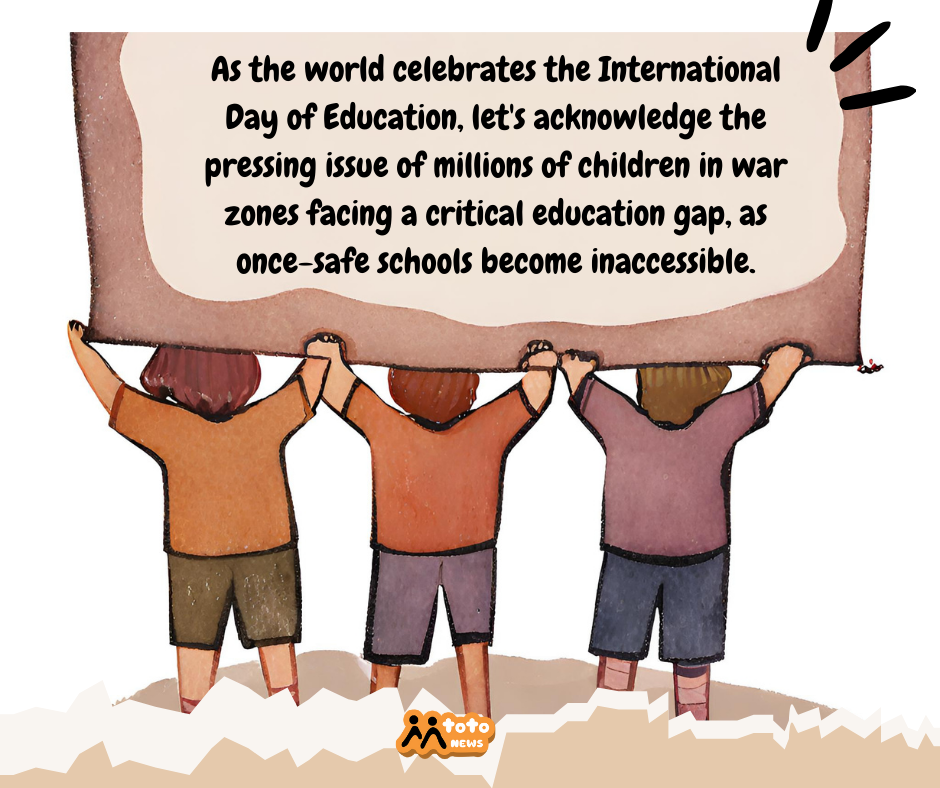Children living in war zones are deprived of the opportunity to pursue a normal curriculum, shattering their dreams of becoming architects, engineers, doctors, journalists and more. Instead, they are forced to focus on survival skills amid the harsh realities of hunger and the constant threat of bombings.
As the world is celebrating the international day of Education, they need to know that children living in wars have forgotten the sweetness of learning, children in Congo, Palestine, Sudan, Syria, Somalia, Afghanistan and other countries are being deprived of one of the most important basic needs a child has the right to.
From January 2023 to August 2023, almost 300,000 children in Eastern DRC faced a devastating setback as nearly 1,000 schools closed. This crisis is not just a number, it represents the dreams denied and futures at risk.
Reasons for this educational emergency are complex, involving a long term conflict, lack of resources, and economic challenges. For these children, it means missing out on learning, breaking free from poverty, and building a brighter future.
The world is overlooking the children of Eastern DRC. Their right to education is essential, and their potential is a key to the region’s recovery. Ignoring this crisis risks creating a lost generation, and we can’t afford to let that happen. It’s time to act for the sake of these children and the world’s shared future.
Moreover After more than a hundred days of nonstop Israeli airstrikes on the besieged Gaza Strip, hundreds of thousands of children struggling with the day-to-day horrors of conflict no longer have access to education due to the severe disruption of schools and classrooms, teacher displacement, or the tragic loss of their lives. Regrettably, the ongoing genocide in the Middle East has claimed yet another victim: education.
The Palestinian Health Ministry’s most recent statistics show that there were 2.2 million people living in the Gaza Strip prior to the war, more than half of whom were school-age children.
Over 25,000 Palestinians, many of them women and children, have died as a result of the IDF’s actions, which occurred almost four months after Hamas attacked southern Israel.
Relief organizations caution that as hope wanes, many of the children who are still alive are finding it difficult to tell the difference between life and death. On top of being forcibly displaced, having no access to basic supplies, and experiencing violence, they also have to deal with the loss of friends and family, physical harm, amputations, and the trauma that has persisted since the crisis.
According to data shared by UNICEF with Al Arabiya English, as of January 8, 2024, the war’s severe effects on the Gaza Strip included over 433,000 affected students and 16,000 teachers.
Out of these tragic numbers, 227 teachers and 4,275 students between the ages of six and seventeen have died. With UNICEF estimating that 90% of school buildings are accommodating internally displaced Palestinians at four times their intended capacity, it is clear that there is an overwhelming demand on school infrastructure.
Education institutions, which are typically viewed as safe havens offering comfortable surroundings and peer support, have become the most recent casualties in the lives of thousands of young people in the besieged enclave, further disrupting the situation.
The education system is in terrible shape, with about 270 schools either completely or partially damaged, according to Hani Shehada, head of the Education Above All (EAA) foundation’s Palestinian office. He noted from Paris that there is no space left for educational activities because some of the remaining schools are now used as shelters from Israeli bombings.
Experts caution against the impending long-term destruction for the youth of Palestine as the world observes the International Day of Education. Now that they are denied access to the once-safe haven of schools, hundreds of thousands of people struggle with a serious education gap. This crisis exacerbates the trauma left by the devastation of war, presenting a clear picture of the difficulties facing Palestinian youth in the future.

